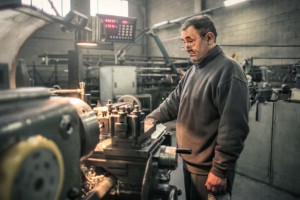 Line balancing is one of the important methods for improving your production system. The idea is to give every process the same workload so all processes are busy all the time. However, there are cases where it may be better NOT to balance a line. This post will look into when and why you may choose not to balance your line.
Line balancing is one of the important methods for improving your production system. The idea is to give every process the same workload so all processes are busy all the time. However, there are cases where it may be better NOT to balance a line. This post will look into when and why you may choose not to balance your line.
Introduction
 Line balancing aims to give every process a constant equal workload. This will reduce wasted waiting time (muda) for those with too little work and overburden (muri) for those with too much. Altogether it reduces unevenness (mura). I have written a six post series on line balancing, starting with Line Balancing Part 1 – Data Overview.
Line balancing aims to give every process a constant equal workload. This will reduce wasted waiting time (muda) for those with too little work and overburden (muri) for those with too much. Altogether it reduces unevenness (mura). I have written a six post series on line balancing, starting with Line Balancing Part 1 – Data Overview.
The reason we do line balancing is to reduce muda, mura, and muri, as mentioned above. However, there are situations when the negative effects of an imbalanced line are offset by other possible benefits, making an imbalanced line more sensible.
Automatic Processes

The first and most common reason not to balance a line is when you have automatic processes. The philosophy at Toyota is that it is very disrespectful to let human workers wait. However, they don’t care (too much) if a machine has to wait.
Hence, when balancing a line, it is important to balance the manual work. Automatic processes merely have to be fast enough so as not to slow down the rest of the line. In theory, this means the cycle time of the automatic processes have to be equal or faster than the cycle time of the manual processes. In reality, however, it is advisable to have the automatic processes even a bit faster than the manual processes. This reduces the likelihood of the automatic process slowing down the manual ones. Exactly how much faster the automatic processes should be depends on three things:
- Fluctuations: The more the automatic OR manual processes fluctuate, the better it is to have a faster automatic process. This reduces the likelihood of making the manual processes wait.
- Buffer: Having a large buffer capacity before and after the automatic processes can reduce the effect of fluctuations. Hence, larger buffers reduce the likelihood of having the manual process wait on the automatic one and hence reduce the speed requirements for the automatic processes.
- Cost: It would be nice to have a faster automatic process, but you have to watch the cost. If a faster automatic process costs you a LOT more than a just barely fast enough one, you may choose to go with the cheaper process.

Overall, an automatic process that is faster than the rest of the line does not hurt the overall performance of the line. On the contrary, it may reduce the waiting time of the workers on the automatic processes, and hence improve overall performance. It also makes it easier in the future if you need to squeeze more parts out of the line. Manual workplaces are often easier and cheaper to optimize than automatic ones. In the worst case, you can simply create more manual stations and add more workers to speed up the line. However, speeding up an automatic process is often costly. You need probably more hardware, and a programmer that makes everything work again … and again if it didn’t work out the first time … and again … and again. In sum, making an automatic process faster often takes more time, money, and effort than improving a manual station. Semi-automates processes fall somewhere in between.
Hence, having a faster machine to begin with does not hurt at all. You may even choose to get a faster machine from the very beginning to future-proof your line if you expect higher demand in the future. Although you would have to balance this with the cost of the faster automatic process. If you have a fast machine sitting around anyway, just use it. If you have a machine custom made, discuss with the supplier the price increase for a faster machine. Under no circumstances should you explicitly slow down an automatic process just to balance a line.
Processes That Cannot Stop Easily
 Another example where a line may be better off imbalanced is processes that are difficult to stop. These are often continuous processes. For example, let’s take a food processing line. You are baking bread or pizza in a continuous oven. The time in the oven is determined by the required baking temperature and duration, the latter of which is set through the speed (and length) of the belt in the oven. You can only stop the oven if it is empty, or you will damage your goods and potentially even start a fire with your (no longer) food stuff. Hence, the stopping of this baking process has the additional requirement that it is empty.
Another example where a line may be better off imbalanced is processes that are difficult to stop. These are often continuous processes. For example, let’s take a food processing line. You are baking bread or pizza in a continuous oven. The time in the oven is determined by the required baking temperature and duration, the latter of which is set through the speed (and length) of the belt in the oven. You can only stop the oven if it is empty, or you will damage your goods and potentially even start a fire with your (no longer) food stuff. Hence, the stopping of this baking process has the additional requirement that it is empty.

This additional requirement complicates a lot of things. In a production line with FIFO buffers, one important concept is that the process must stop if the subsequent buffer is full. This prevents overproduction. However, unless we want to throw out all the stuff that got stuck in the oven, you have to stop the oven before the buffer gets full. The remaining items still go through the oven and then are buffered. This is possible, although there are two problems.
First, depending on your system, it may still affect quality slightly. Since there is less cold produce entering the oven, the temperature may be a tad higher and the products a tad more well done. Similarly, the first products that go through after the stop may also be slightly overcooked.
 Second, you have to stop the oven before the buffer is full. This requires foresight, which may or may not be in plenty on your shop floor. Chances are, every now and then you may miss the cutoff point and end up with defective products. Additionally, there is also often a hesitation of the employees to turn of machinery. Maybe they turned it off before because a problem was coming up downstream, but the problem was fixed faster than expected and no turn-off would have been necessary. Management – with the wisdom of hindsight – may have then yelled at the workers for why they turned off the machine. A good standard can help, but it will only reduce the likelihood of it happening.
Second, you have to stop the oven before the buffer is full. This requires foresight, which may or may not be in plenty on your shop floor. Chances are, every now and then you may miss the cutoff point and end up with defective products. Additionally, there is also often a hesitation of the employees to turn of machinery. Maybe they turned it off before because a problem was coming up downstream, but the problem was fixed faster than expected and no turn-off would have been necessary. Management – with the wisdom of hindsight – may have then yelled at the workers for why they turned off the machine. A good standard can help, but it will only reduce the likelihood of it happening.
It may be much less of a hassle to design the processes before and after the oven faster than the oven itself. This would allow you to manage more fluctuations in the process through additional capacity before and after the oven. Subsequently, the oven has to be stopped less if there is a minor problem. Hence, you turn the oven into an intentional bottleneck, so that the oven does not stop because of other processes.
We can find similar examples in many industries, from steelmaking to paper mills, which are also my examples for the next reason not to balance your line.
Very High Investment Processes
 Another situation where a production flow is created intentionally imbalanced is with processes that have significantly higher investment cost than other surrounding processes. A common example here is a paper machine or a blast furnace to make steel. While these are also difficult to turn off as explained previously, they are also a much higher investment that the processes that surround them.
Another situation where a production flow is created intentionally imbalanced is with processes that have significantly higher investment cost than other surrounding processes. A common example here is a paper machine or a blast furnace to make steel. While these are also difficult to turn off as explained previously, they are also a much higher investment that the processes that surround them.

Let’s take the paper mill as an example. The machine that actually makes the paper is quite big and expensive. It makes a roll of paper (called a tambour) 12 meters (or more) wide and easily weighing 100 tons (or more). This roll is subsequently cut into smaller rolls, which then in turn are cut into sheets of paper, which then are packaged and shipped. If the line would be evenly balanced, it would be as likely to have the cutting process wait on the paper machine as the other way round.
A lost minute at the paper machine is much more expensive than a lost minute at the cutting machine. However, this is a somewhat theoretical calculation of cost accounting. More relevant is that it is much cheaper to create extra capacity at the cutting machine than at the paper machine, increasing the overall output for little money. Therefore, here, too, the paper machine is intentionally the bottleneck, and the value stream is intentionally imbalanced.
Summary
Overall, there are situations where imbalanced lines are sensible. Please note that when I say “not to balance a line,” I don’t mean to just throw the process speeds together randomly. You still have to think about it, and select certain workloads or speeds for certain processes. Different from the normal balancing, you just intentionally create an imbalance, and only if you have a good reason for this. Most lines should still be well balanced, and intentionally imbalanced lines are less common. Now, go out, balance your line (unless you have a reason not to), and organize your industry!
P.S.: This blog post originated from a small discussion between Prasad Velaga, Erik T. Hansen, and me on LinkedIn.

Interesting! It would be cool to see a post explaining how capacity levelling (multiple orders) and balancing (one particular order) fit together and impact each other (if at all).
Interersting article. Please allow me to share our article which describes line balancing from a different angle and also proposes the use of digital tools to improve line balancing: https://workerbase.com/how-to-use-line-balancing-in-lean-manufacturing-and-improve-with-digital-tools/
A few thoughts on this one.
The area where I work at consists mostly of manual processes that feed the units into a chain of five automatic processes that are much faster. Here’s the catch, though…
The auto chain is fairly prone to breakdowns, since any of the processes going down stops the chain. When that happens, we keep working and stack the ready units on floor by the first machine. When the chain restarts, we catch up production by feeding the stackoffs to keep the machines busy.
Another thought. You mention that Japanese consider it disrespectful to the worker to wait on a machine. What about the more physically intensive manual processes? Sometimes, wouldn’t “waiting” be a sensible quick built-in break to let the worker catch their breath?
On a related note, when machines are much faster than the workers could ever hope to be, how do the Japanese deal (if they even do) with the fact that it puts a huge amount of pressure on the workers to work absolutely as fast as their physical ability allows?
Great article! It was a pleasure to read it! Well done!
Hi Andrey, nice example. The automatic systems are faster, and are decoupled by buffers (bins on the floor). Makes total economic sense, and also better not to let the workers wait.